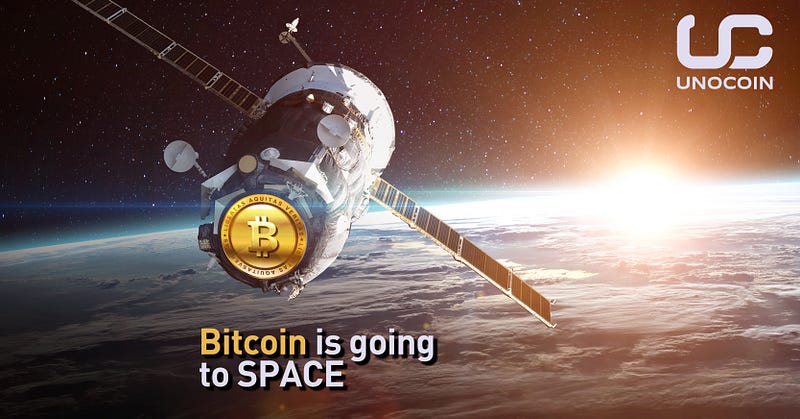
Ever since bitcoin came into existence, it has been a much better alternative to fiat money as a decentralised, peer to peer cryptocurrency free from governmental manipulation, control, and surveillance. With anonymity and security as its unique selling points, bitcoin has captured the public imagination overcoming external setbacks and governmental opposition.
Now the system is only set to get more robust with the transmission of the bitcoin blockchain from space. Blockstream, a private company, now streams the blockchain from space through rented satellites.
The service is now available for free across the Americas, Africa and most parts of Europe. The satellite transmission of the blockchain preserves the integrity of bitcoin as one cryptocurrency with one public ledger (blockchain) even if the internet goes down and also opens up access to bitcoin to people who aren’t connected to the internet.
Redundancy of connections between nodes
The integrity of transactions made using bitcoin is ensured by a public ledger called the blockchain, which contains a record of all transactions ever made with bitcoin. The complete blockchain, which has a size of 160 gigabytes, is now maintained in servers or computers which are called nodes. These are used as references in validating new transactions. The validated transactions are then added to the blockchain maintained by these nodes. To validate every transaction, information of the transaction is sent through nodes until one node validates it and the new validated transaction is accepted and incorporated into the blockchain by every node.
For every node to have the same blockchain, that is, the same record of transactions made, they must be connected to each other all the time. This is essential if bitcoin has to stay as a single cryptocurrency. If there is a disconnection in the peer to peer network between nodes, that is, if a node or a group of nodes is isolated from the rest, two versions of the blockchain are formed and bitcoin ceases to be a single currency.
Thus, it has to be ensured that nodes don’t get isolated or separated from the network. The risk of separation can be made negligible by introducing redundancy into the system. If nodes are connected to each other in multiple ways using different modalities of data transmission, it makes the system that much more resilient in the face of disruption.
Satellite transmission of blockchain
Nodes with the blockchain exchange information with each other through the internet. The internet connects servers throughout the world via fiber optic cables that run through the ground and underwater. If this transmission link is cut due to disruption of the fiber optic cables, for example, a transatlantic cable disruption, an entire continent’s internet would be isolated from the rest of the world’s internet. Record of any transaction made using bitcoins during this period of separation is not shared between the separated nodes and eventually, even when the connection is restored, such transactions are not recognised by the now reconnected nodes.
To prevent this from happening, it must be ensured that the nodes stay connected no matter what. A step in this direction is the beaming of the blockchain to almost all areas of the world from geosynchronous satellites by Blockstream, a private company. Thus, even if the internet connection between nodes is disrupted, nodes could synchronise by sharing data through the satellite connection.
Further, beaming the blockchain from space also serves a noble cause in enabling universal access to bitcoin.

Opening up access to the needy
The people most in need of bitcoin in poorly performing economies with bloated currencies are often those who lack access to the internet and by extension, bitcoin. In such areas where an internet connection could be prohibitively expensive, satellite transmission of the blockchain could be a boon. It takes less than $100 to set up a node and receive blockchain data forever from the satellite for free. All one requires is a personal computer, a TV satellite dish, a USB dongle and a receiver. Entire communities could pitch in and maintain a node at almost zero maintenance cost while gaining access to bitcoin. Though internet would still be required to transact in bitcoins, the cost would be very low for data transfer involved in bitcoin transactions. Other solutions such as short messaging service (SMS) can also be utilised to enable transactions in bitcoin.
The move by Blockstream to beam the bitcoin blockchain via satellite will benefit scores of underprivileged and needy people as bitcoin, a universal, strong currency, could revive their livelihoods and economies. It also serves as a backup or redundant modality of data transmission helping nodes stay connected in case things go awry with the internet connection.
Blockstream is hoping to cash in on subscription from node owners who want to make sure their nodes always stay connected with the bitcoin peer to peer network. Blockstream also plans to allow developers to develop products around bitcoin that could be beamed from satellites and make money from the added services. Plans are afoot to lease more satellites to reach Asia and Australia within this year.
Let’s wrap up what we just learned
- As a peer to peer cryptocurrency, the blockchain is integral for bitcoin as a validated record of transactions
- Many blockchains and multiple versions of bitcoin may result if communication between nodes is broken and thus, it is essential to keep the nodes connected.
- Blockstream’s satellite blockchain streaming service offers assurance that nodes will stay connected even if the internet goes down.
- Blockstream’s service could also help the underprivileged and needy access bitcoin, with limited or no access to the internet.
- It costs less than $100 to set up and maintain a node for a lifetime with Blockstream’s service.

Also Read:
https://blog.unocoin.com/bitcoins-segwit-explained-5dc6b0afcb08






